AI Digital Tools: 10 Powerful Ways to Boost Success in 2025
Why AI Digital Tools Are Changing How We Work and Create
AI digital tools are revolutionizing everything from content creation to customer service, with over 75% of marketers already using them to boost productivity and engagement. These intelligent software applications leverage artificial intelligence to automate tasks, generate content, analyze data, and make smart decisions that would traditionally require human expertise.
Here’s what AI digital tools can do for you:
• Content Creation – Generate blog posts, social media captions, images, and videos in seconds
• Productivity – Automate scheduling, project management, and routine tasks
• Marketing – Optimize ads, analyze customer sentiment, and personalize campaigns
• Research – Summarize documents, answer complex questions, and gather insights
• Security – Detect threats, ensure compliance, and protect sensitive data
• Communication – Power chatbots, transcribe meetings, and translate languages
The numbers speak for themselves. Companies like Harley Davidson saw a 2,930% increase in leads after implementing AI advertising tools. Meanwhile, 8 of the top 10 US banks now use AI-powered software automation to streamline their operations.
But here’s the thing – not all AI tools are created equal. Some excel at creative tasks, others at data analysis, and many require careful setup to work properly. The key is understanding which tools fit your specific needs and how to implement them responsibly.
I’m Samir ElKamouny AV, and I’ve spent years helping businesses scale through strategic marketing and technology adoption, including the integration of AI digital tools into workflows that drive real results. Throughout this guide, I’ll show you exactly which tools are worth your time and how to use them effectively.
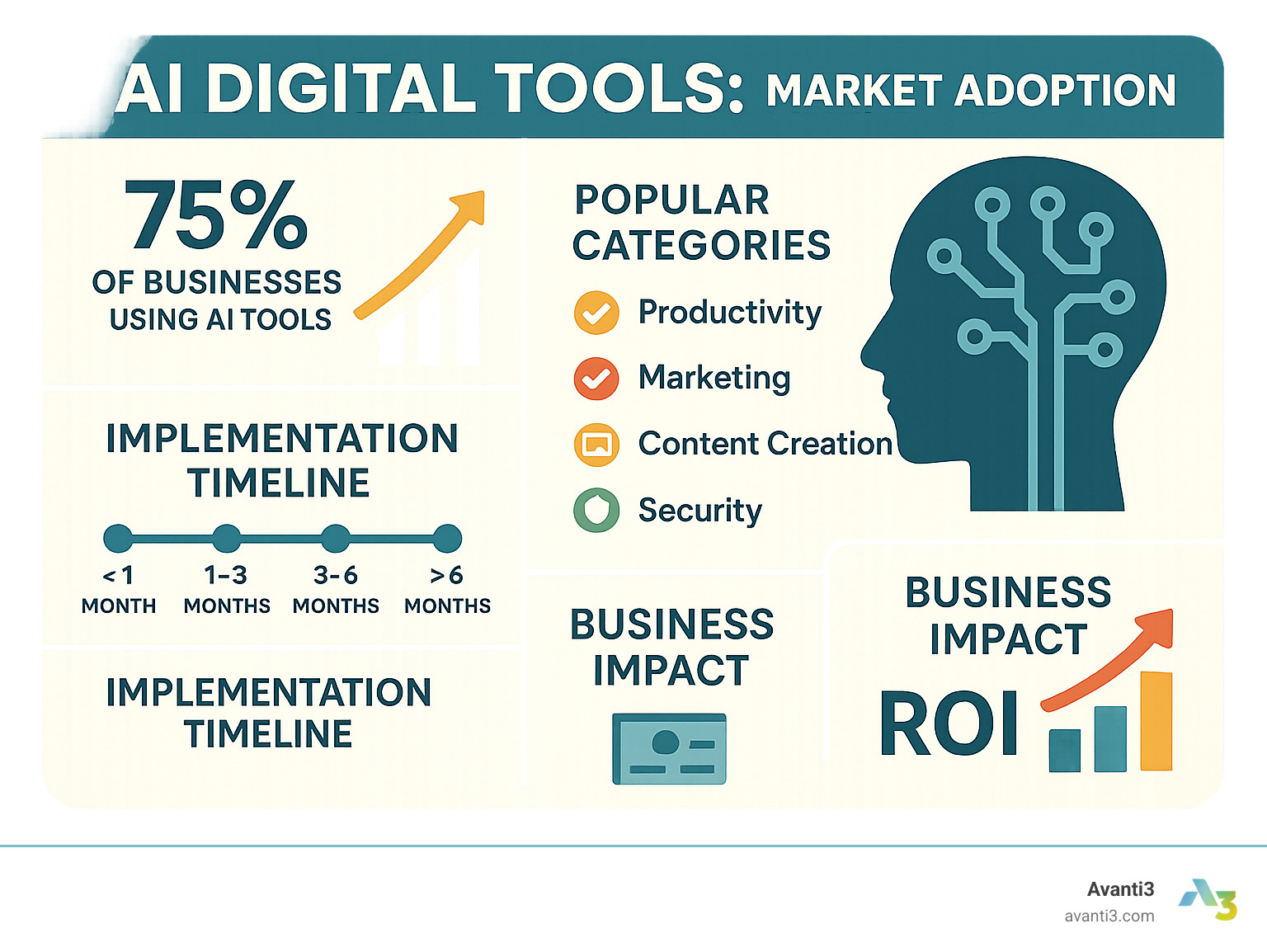
Essential AI digital tools terms:
– digital engagement for sales cloud
– digital engagement service cloud
What Are AI Digital Tools & Why They Matter in 2025
Imagine having a digital assistant that never needs coffee breaks, doesn’t get overwhelmed by data, and keeps getting smarter every day. That’s essentially what AI digital tools are – software applications powered by artificial intelligence that can tackle tasks we used to think only humans could handle.
These aren’t just fancy calculators or basic automation scripts. AI digital tools can understand context, learn from patterns, and make intelligent decisions. They’re like having a really smart colleague who happens to be made of code instead of coffee and determination.
The change happening across industries is honestly pretty remarkable. In finance, we’re seeing 8 of the top 10 US and European banks use AI-powered automation to handle their software releases more smoothly. Healthcare professionals are getting AI assistance with diagnosis and treatment planning, while educators are using platforms like Gradescope to streamline grading and give students better feedback.
But here’s where it gets really interesting – the numbers don’t lie. Companies implementing AI digital tools are seeing some jaw-dropping results. Harley Davidson case? They experienced a 2,930% increase in leads after bringing AI into their advertising strategy. That’s not a typo – that’s the kind of productivity boost that makes executives do double-takes.
Research shows these tools can cut writing time in half while boosting user engagement by 85%. That’s the sweet spot where efficiency meets effectiveness.
Now, let’s be real for a moment. AI digital tools aren’t magic wands that solve every problem. They’re incredibly good at recognizing patterns and handling repetitive tasks, but they still need human oversight for creative decisions, ethical considerations, and understanding nuanced contexts.
The secret sauce? It’s what we call the human-in-the-loop approach. Think of AI as your super-powered sidekick rather than your replacement. You bring the creativity, strategy, and emotional intelligence. AI brings the speed, data processing power, and tireless consistency.
AI Digital Tools in Everyday Workflows
The real magic of AI digital tools shows up in how they transform daily workflows. Instead of drowning in routine tasks, teams can focus on what actually moves the needle forward.
Take chatbots, for instance. They’re handling those repetitive customer questions that used to eat up hours of human agent time. Meanwhile, your actual team members can tackle the complex problems that require empathy, creativity, and strategic thinking.
Multimodal assistants like Google’s Gemini are taking this even further. These tools can process text, images, and voice all at once, making them incredibly versatile for different situations. It’s like having a Swiss Army knife for digital tasks.
Picture this: a marketing team uses AI to automatically draft email responses, schedule social media posts, and analyze campaign performance. While the AI handles these operational tasks, the humans focus on developing creative campaigns and building relationships with customers. Everyone’s working in their zone of genius.
AI Digital Tools for Strategic Decisions
Beyond just making daily tasks easier, AI digital tools are becoming powerful allies for strategic decision-making. They excel at predictive analytics and turning mountains of data into actionable insights.
These tools can spot trends you might miss, predict how customers will behave, and suggest strategic moves based on real data rather than gut feelings. When companies use AI for digital advertising optimization, they’re essentially getting a data scientist that works 24/7 and never gets tired of crunching numbers.
That Harley Davidson success story? It happened because AI could process customer data and optimize campaigns in real-time, making adjustments faster than any human team could manage.
The University of Miami offers another great example of strategic AI implementation. They’ve carefully curated AI digital tools for both general productivity and specialized academic functions, ensuring they get maximum value from their investments. It’s not about using every shiny new AI tool – it’s about choosing the right ones that actually solve real problems.
This strategic approach to AI adoption is what separates the success stories from the expensive experiments that don’t deliver results.
Main Categories of AI Digital Tools
Think of AI digital tools as a vast digital toolbox, where each category serves a specific purpose in your workflow. Just like a carpenter wouldn’t use a hammer for every job, successful organizations build an integrated ecosystem of AI tools that work together seamlessly.
The beauty lies in how these categories complement each other. A marketing team might use productivity tools to automate scheduling, content creation tools to generate campaigns, and security tools to protect customer data – all working in harmony to amplify their capabilities.
Productivity & Collaboration AI Digital Tools
Task automation has become the backbone of modern workflows. Tools like Zapier connect over 3,000 different applications, letting you create seamless workflows without writing a single line of code. Imagine your customer service emails automatically triggering project updates, which then schedule follow-up meetings – all happening behind the scenes.
Smart scheduling takes this further. AI digital tools like Reclaim and Motion don’t just organize your calendar – they actively protect your deep work time. These tools analyze your priorities and availability, automatically blocking focus time and optimizing meeting schedules based on when you’re most productive.
Project management platforms are getting smarter too. They now predict project timelines, spot potential bottlenecks before they happen, and suggest better ways to allocate resources. It’s like having a project manager who never sleeps and learns from every completed task.
Marketing, Sales & Customer Experience AI Digital Tools
Here’s where things get exciting. With 75% of marketers already using AI tools, this space is exploding with innovation. Personalization engines analyze how customers behave and deliver exactly the right content at the perfect moment. It’s like having a personal shopper for every single visitor to your website.
Ad optimization platforms work around the clock, automatically adjusting bidding strategies and tweaking creative elements to maximize your return on investment. Harley Davidson success story? That’s the power of AI constantly fine-tuning campaigns based on real-time data.
Social listening tools powered by AI monitor brand mentions across the entire internet. They analyze sentiment, alert you to potential issues, and spot opportunities before your competitors do. It transforms marketing from playing defense to staying three steps ahead.
Content Creation & Creative Suite AI Digital Tools
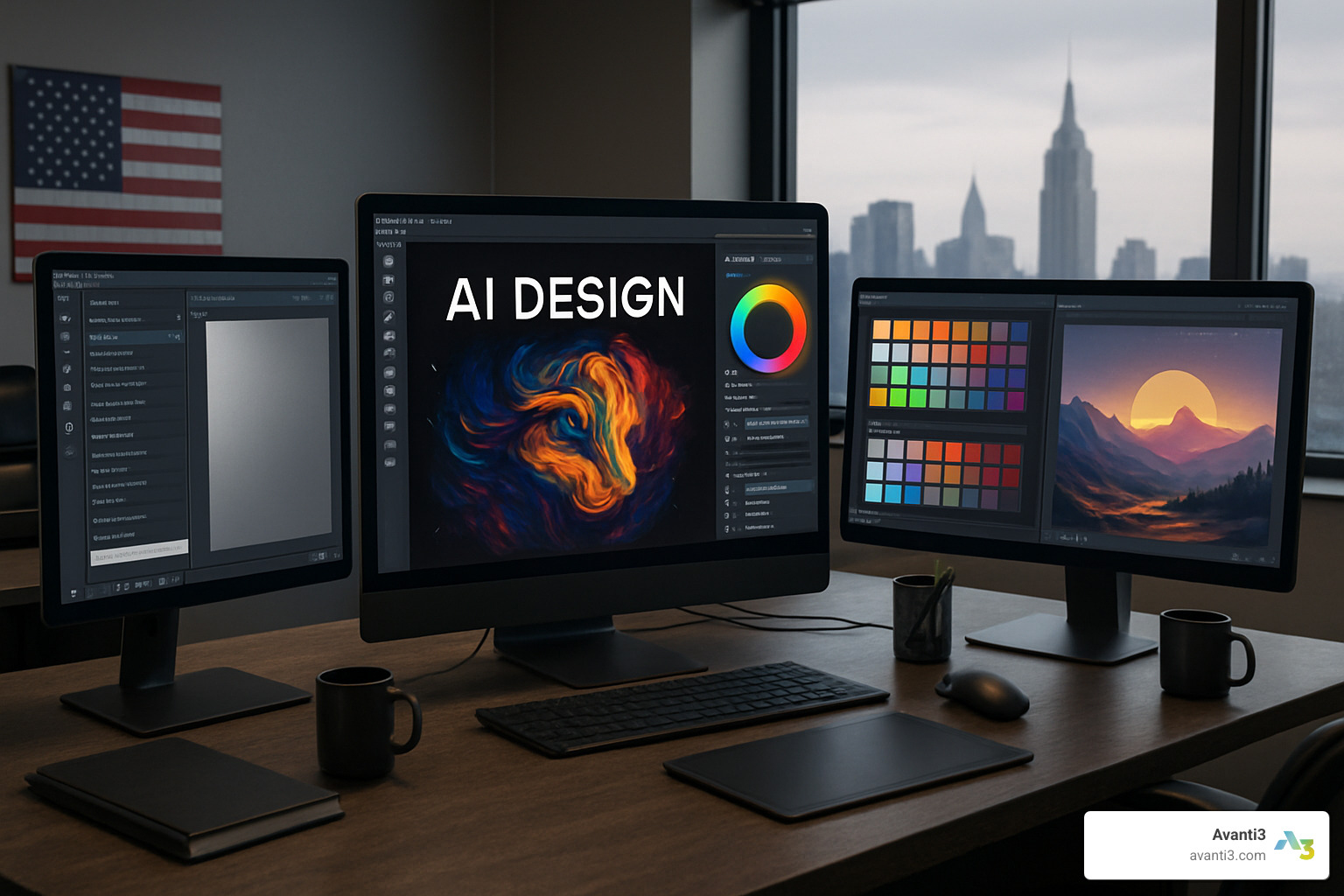
The content creation revolution is here, and it’s democratizing creativity like never before. Generative text platforms can produce everything from blog posts to product descriptions, while image generation tools create custom visuals in seconds. Video editing AI automatically cuts footage, adds smooth transitions, and even generates synthetic voices for narration.
What’s truly remarkable is how these AI digital tools level the playing field. A small business owner can now create professional-looking marketing materials that would have required an entire design team just a few years ago. The barrier to entry for creative work has practically disappeared.
The key is understanding that these tools improve human creativity rather than replace it. They handle the heavy lifting so you can focus on strategy, storytelling, and the uniquely human elements that make content truly engaging.
Security, Privacy & Compliance AI Digital Tools
Threat detection represents one of the most critical applications of AI digital tools. These systems use machine learning to identify unusual patterns that might signal cyberattacks – often catching threats that traditional security measures would miss entirely.
The trust in AI-powered security is growing rapidly. 57 government entities now rely on AI-powered platforms for secure software delivery, which speaks volumes about the reliability and effectiveness of these systems.
Governance and compliance tools ensure your AI implementations meet regulatory requirements. Zero-trust security frameworks powered by AI continuously verify user identity and device integrity, providing robust protection for sensitive data without slowing down legitimate work.
Research & Decision-Making AI Digital Tools
Knowledge graphs and RAG systems (Retrieval-Augmented Generation) represent the cutting edge of research-focused AI digital tools. These systems process vast amounts of information and provide accurate, cited responses to complex questions – like having a research assistant with perfect memory and instant access to all human knowledge.
Autonomous agents are emerging as the next frontier. These sophisticated tools can perform multi-step tasks with minimal human intervention, learning and adapting as they work.
Learn more about Project Astra, Google’s research prototype that points toward future AI assistants capable of understanding and interacting with the world around us. It’s a glimpse into a future where AI tools become true collaborative partners in our work and creative endeavors.
Top AI Digital Tools Powering Industries in 2024–2025
The world of AI digital tools has exploded with innovation this year, and honestly, it’s pretty exciting to see how far we’ve come. What started as simple chatbots has evolved into sophisticated research partners that can handle complex conversations and multi-step tasks.
Voice AI technology has made incredible leaps forward. Today’s systems can generate natural-sounding speech in hundreds of languages and voices – some so realistic you’d swear you’re talking to a human. This breakthrough is changing everything from customer service to content creation.
DevSecOps platforms are quietly revolutionizing how software gets built. These AI digital tools integrate intelligence throughout the entire development process, from writing code to testing security vulnerabilities to managing deployments. It’s like having an expert developer looking over your shoulder at every step.
Educational institutions are embracing AI-powered grading systems that do more than just mark papers. These tools provide detailed, personalized feedback while giving educators their time back to focus on what they do best – teaching and mentoring students.
Stand-Out AI Digital Tools for Businesses
Enterprise automation platforms are changing the game for businesses of all sizes. Digital release automation tools help organizations manage complex software deployments across both traditional servers and cloud environments. What makes these tools special isn’t just that they automate tasks – they provide intelligent orchestration that adapts when things don’t go according to plan.
The beauty of modern AI digital tools lies in how they work together. Instead of juggling dozens of separate applications, smart businesses are choosing platforms that offer comprehensive toolsets. This approach delivers better value than trying to piece together individual solutions. Visit Integrations Marketplace to see how different AI capabilities can seamlessly work together in enterprise environments.
Secure software delivery has become a top priority, and AI-powered platforms are making it possible to maintain both speed and security without compromise.
Stand-Out AI Digital Tools for Individuals
Personal productivity has gotten a major upgrade thanks to AI digital tools designed for individual users. AI-powered note-taking applications can now summarize entire meetings, pull out action items automatically, and even generate audio overviews of documents you upload. It’s like having a personal assistant who never forgets anything.
Resume builders have become incredibly sophisticated, using AI to optimize your content for applicant tracking systems and specific job requirements. These tools understand what recruiters are looking for and help you present your experience in the best possible light.
Personal AI agents are getting smarter every day. They’re learning individual preferences and work styles to provide truly personalized assistance that feels natural and helpful rather than robotic.
Real-World Wins with AI Digital Tools
The Harley Davidson success story shows just how powerful AI digital tools can be when implemented strategically. Their 2,930% increase in leads wasn’t a fluke – it was the result of AI-powered advertising that could analyze customer data and optimize campaigns in real-time, making adjustments faster than any human team could manage.
Universities are seeing equally impressive results with AI-powered grading systems. Learn More about Gradescope usage demonstrates how educational institutions are using these tools to provide faster, more consistent feedback to students while dramatically reducing faculty workload.
The banking industry offers another compelling example. Major financial institutions are using AI digital tools for automation, accelerating application deployment times and improving customer experiences. When you can process requests faster and more accurately, everyone wins.
These real-world examples prove that AI isn’t just hype – it’s delivering measurable results for organizations willing to accept the technology thoughtfully.
Implementing AI Digital Tools Responsibly: Security, Ethics & Best Practices
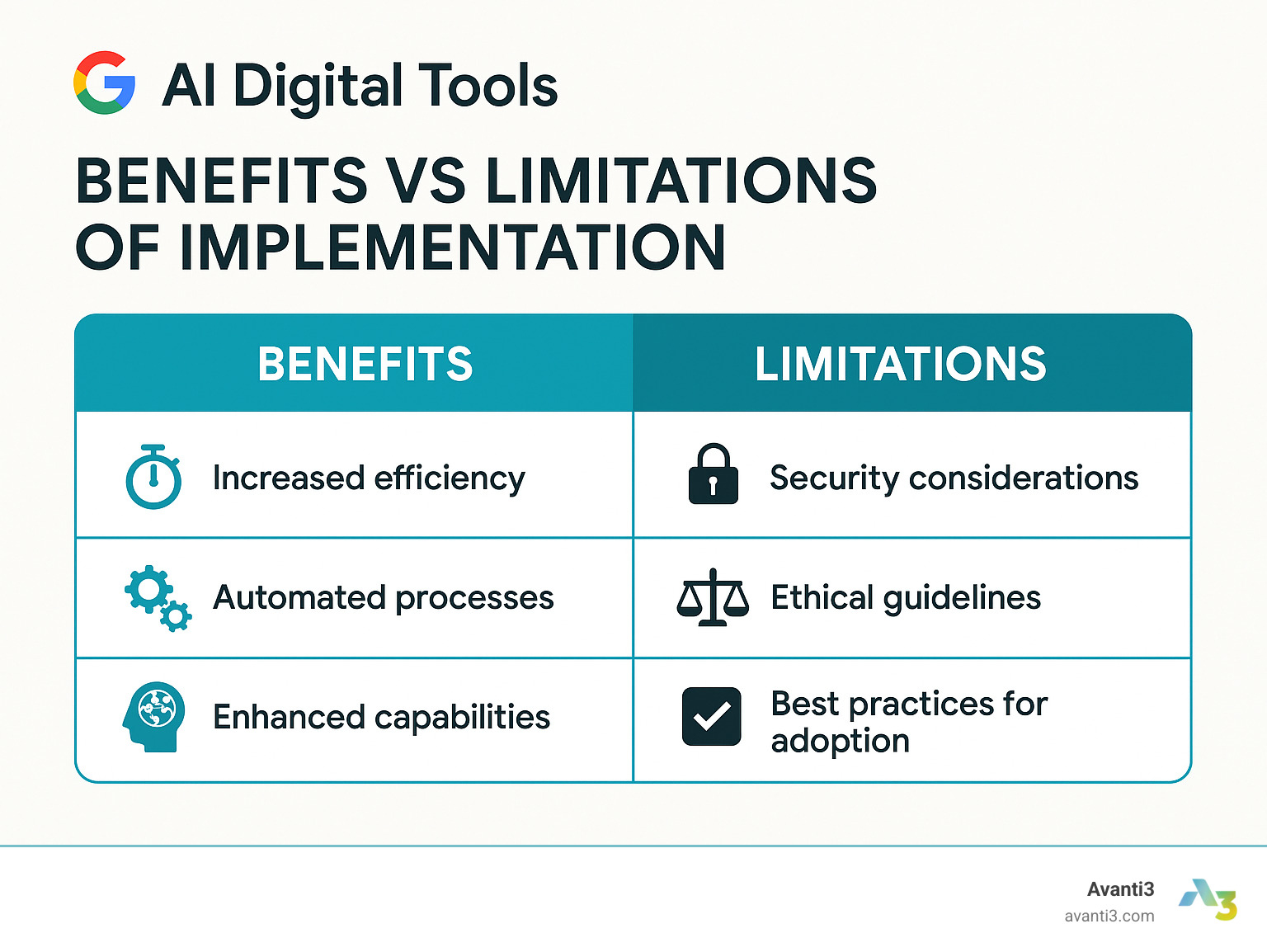
Getting excited about AI digital tools is easy. The hard part? Making sure you implement them the right way. Think of it like getting a powerful sports car – sure, it can go fast, but you need to know how to drive it safely.
The truth is, many organizations rush into AI adoption without proper planning. They get caught up in the hype and forget about the fundamentals: governance, data privacy, and bias mitigation. These aren’t just buzzwords – they’re the foundation that determines whether your AI implementation succeeds or becomes a costly mistake.
Vendor assessment goes way beyond checking if the tool works. You need to dig into their security practices, understand how they handle your data, and verify they comply with regulations that matter to your industry. A flashy demo means nothing if the vendor can’t protect your sensitive information.
Here’s what many people don’t realize: change management often makes or breaks AI implementations. These tools don’t just automate tasks – they fundamentally change how work gets done. Your team needs time to adapt, proper training, and clear communication about how AI will improve their work rather than threaten their jobs.
The most successful companies I’ve worked with treat AI implementation like a marathon, not a sprint. They start small, learn from each step, and gradually expand their AI capabilities while maintaining strong oversight throughout the process.
Selecting the Right AI Digital Tools
Stop choosing AI digital tools based on what’s trending on social media. I’ve seen too many businesses waste money on shiny tools that don’t solve their actual problems. Start with a honest needs analysis – what specific challenges are slowing down your team? What repetitive tasks eat up valuable time?
Once you know what you need, focus on scalability and integration capabilities. The best AI tool in the world becomes useless if it can’t grow with your business or play nicely with your existing software. Ask yourself: will this tool still serve us well when we’re twice our current size?
Don’t fall for feature overload either. A tool that does ten things poorly is worse than one that does three things exceptionally well. Look for solutions that excel at your core needs rather than trying to be everything to everyone.
Ethical & Responsible AI Digital Tools Guidelines
Transparency isn’t just a nice-to-have – it’s essential for building trust with your team and customers. When your AI makes a recommendation or decision, you should be able to explain the reasoning behind it. This becomes especially critical when AI decisions affect people’s careers, finances, or opportunities.
Compliance frameworks provide the guardrails your organization needs. Establish clear policies about how data gets used, when algorithms need auditing, and what level of human oversight is required. These policies might seem restrictive at first, but they actually give your team confidence to use AI tools more effectively.
Human oversight remains the most important element of responsible AI use. The goal isn’t to replace human judgment – it’s to improve it. The most effective AI digital tools implementations I’ve seen use artificial intelligence to handle routine work while keeping humans in charge of creative decisions and ethical considerations.
Securing Your AI Digital Tools Stack
Encryption protects your data whether it’s sitting in storage or moving between systems. Look for platforms that use enterprise-grade security measures like AES-256 encryption for stored data and TLS 1.3 for data transmission. These technical details matter more than you might think.
Access controls ensure only the right people can use your AI capabilities. Multi-factor authentication and role-based permissions create layers of security without making the tools harder to use. Think of it like having different keys for different rooms in your office.
Incident response planning prepares you for when things go wrong – and they will go wrong eventually. Have clear procedures for handling data breaches, AI system failures, and unauthorized access attempts. The organizations that recover quickly from incidents are the ones that planned for them in advance.
Security isn’t a one-time setup. It’s an ongoing process that evolves as your AI digital tools usage grows and new threats emerge. Regular security reviews and updates keep your systems protected as the landscape changes.
Future Trends & Getting Started with AI Digital Tools
The future of AI digital tools is arriving faster than most of us expected. We’re moving toward incredibly sophisticated multimodal models that can understand and process text, images, audio, and video all at once. Imagine having a conversation with an AI assistant that can see your presentation, hear your voice, and respond with both written feedback and visual suggestions.
Agentic workflows represent another exciting frontier. These systems will complete complex, multi-step tasks with minimal human intervention. Think of an AI that can research a topic, write a report, create supporting visuals, and schedule a meeting to discuss the findings – all from a single request.
The intersection of Web3 technologies with AI opens up fascinating possibilities. Decentralized AI services could give users more control over their data while still accessing powerful AI capabilities. DePIN protocols (Decentralized Physical Infrastructure Networks) might revolutionize how AI tools gather and process real-world information.
Edge AI brings another game-changing benefit: processing power moves closer to where data lives. This means faster responses, better privacy protection, and new possibilities for mobile and IoT applications. Your phone or smart device could run sophisticated AI without sending data to distant servers.
Emerging Horizons for AI Digital Tools
The concept of agent economies sounds like science fiction, but it’s becoming reality. AI systems are learning to perform tasks autonomously, make decisions, and even handle economic transactions. This could fundamentally reshape how we think about work and value creation.
Decentralized AI systems promise to democratize access to powerful capabilities while keeping users in control of their data. This aligns perfectly with growing concerns about privacy and algorithmic transparency that we’re seeing across industries.
For companies like Avanti3 working in the fintech space, AI-fintech integration creates incredible opportunities. We’re talking about more sophisticated financial services, automated compliance monitoring, and truly personalized financial advice that adapts to individual circumstances and goals.
The convergence of AI with blockchain, NFTs, and other Web3 technologies opens doors to new types of digital experiences and community engagement that we’re only beginning to explore.
Beginner’s Roadmap to AI Digital Tools Adoption
Starting your journey with AI digital tools doesn’t have to feel overwhelming. The key is beginning with pilot projects that have clear, measurable outcomes. Pick one specific problem you want to solve and test how AI tools can help. This approach lets you learn how these tools work in your specific context without committing to massive changes.
Upskilling your team matters more than having the fanciest tools. Focus on helping people understand how to work effectively with AI rather than trying to turn everyone into AI experts. The goal is collaboration between humans and AI, not replacement.
Community learning accelerates your progress significantly. Join user groups for the tools you’re considering, attend webinars, and connect with others implementing similar AI solutions. The AI community is surprisingly generous with sharing insights and best practices.
Successful AI adoption is a marathon, not a sprint. Start small, learn continuously, and gradually expand your use of these powerful tools as your comfort and expertise grow.
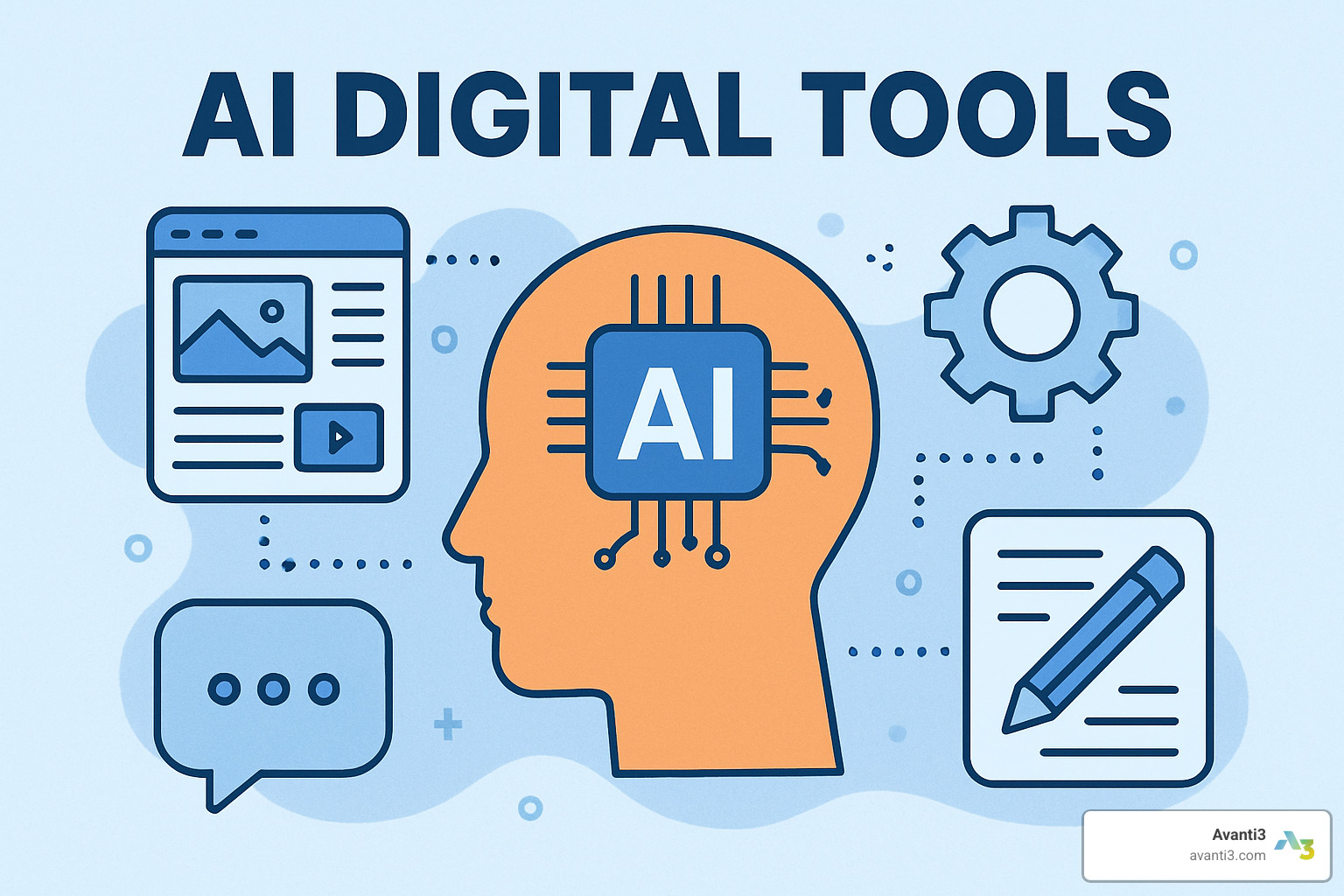
Frequently Asked Questions about AI Digital Tools
What industries benefit most from AI digital tools?
Here’s the honest truth: every industry can benefit from AI digital tools, but some are seeing faster adoption than others. Finance leads the pack – we already mentioned how 8 of the top 10 banks use AI-powered automation. Healthcare follows closely, using AI for everything from diagnosis support to patient scheduling.
Education has acceptd AI grading systems and personalized learning platforms. Marketing teams were early adopters, with that impressive 75% already using AI tools for campaigns and content creation. Software development has been transformed by AI-powered coding assistants and automated testing.
But here’s what really matters: success isn’t about your industry, it’s about finding specific problems AI can solve. A local restaurant might use AI for inventory management, while a law firm could benefit from document analysis tools. The key is starting with clear, measurable goals rather than jumping on the AI bandwagon.
At Avanti3, we see tremendous potential for AI digital tools in the creator economy and fintech space. AI can help creators analyze engagement patterns, optimize content timing, and even generate personalized rewards for their communities.
How do AI digital tools protect sensitive data?
Data security keeps many people awake at night, and rightfully so. The good news is that leading AI digital tools take security seriously, implementing enterprise-grade protection that often exceeds what many organizations have internally.
Most reputable platforms use AES-256 encryption for data at rest and TLS 1.3 for data in transit. They implement strict access controls, multi-factor authentication, and regular security audits. Many offer zero-retention policies, meaning your data isn’t stored or used to train their AI models.
Compliance is another crucial piece. Top AI platforms maintain certifications for GDPR, HIPAA, SOC 2, and other regulatory frameworks. They provide detailed documentation about their data handling practices and often allow you to specify data residency requirements.
However, not all AI tools are created equal. Some free or consumer-focused tools may have less robust security practices. Always review a tool’s security documentation, ask about their data handling policies, and ensure they meet your organization’s specific requirements.
The zero-trust security approach we mentioned earlier is becoming standard. This means continuously verifying user identity and device integrity rather than assuming internal network traffic is safe.
What skills do teams need before adopting AI digital tools?
The skills gap is real, but it’s not as intimidating as many people think. You don’t need a computer science degree to work effectively with AI digital tools. The most important skill is prompt engineering – learning how to communicate clearly with AI systems to get the results you want.
Critical thinking becomes essential because AI tools can produce confident-sounding but incorrect outputs. Teams need to develop the ability to evaluate AI-generated content, spot potential biases, and know when human oversight is necessary.
Change management skills matter just as much as technical knowledge. Successful AI adoption requires helping team members understand how these tools will augment their work rather than replace them. This includes managing concerns, providing adequate training, and establishing clear guidelines for AI use.
Basic data literacy helps teams understand what AI tools can and can’t do with their information. Understanding concepts like training data, model limitations, and output variability leads to more realistic expectations and better results.
The beautiful thing about modern AI digital tools is that they’re designed for everyday users. You don’t need to understand neural networks to use them effectively. Focus on developing good judgment about when and how to use AI, and the technical aspects will follow naturally.
Continuous learning mindset is perhaps the most valuable skill of all. The AI landscape evolves rapidly, and staying curious about new developments will serve teams better than trying to master any specific tool.
Conclusion
The journey through AI digital tools reveals something remarkable – we’re not just witnessing technological change, we’re experiencing a fundamental shift in how work gets done. When Harley Davidson achieved that stunning 2,930% lead increase, or when major banks streamlined their operations, they weren’t just using fancy new software. They were embracing a new way of thinking about human-AI collaboration.
The most successful implementations share a common thread: they improve human creativity and judgment rather than trying to replace it. AI digital tools work best when they handle the repetitive, data-heavy tasks that drain our energy, freeing us to focus on strategy, relationships, and innovation.
Starting your AI journey doesn’t require a complete overhaul of everything you do. Begin with one clear problem you want to solve. Maybe it’s automating your social media scheduling, or getting better insights from customer data, or speeding up content creation. Choose tools that play nicely with your existing systems, and always keep a human in the loop.
The horizon ahead looks incredibly exciting. We’re moving toward a world where AI seamlessly integrates with Web3 technologies, blockchain, and immersive experiences. At Avanti3, we’re already exploring this convergence, helping creators and brands build engagement tools that combine the intelligence of AI with the authenticity of NFTs and the immersion of AR/VR.
This isn’t science fiction – it’s happening right now. AI digital tools are becoming the bridge between traditional digital experiences and the next generation of interactive, personalized, and truly engaging platforms.
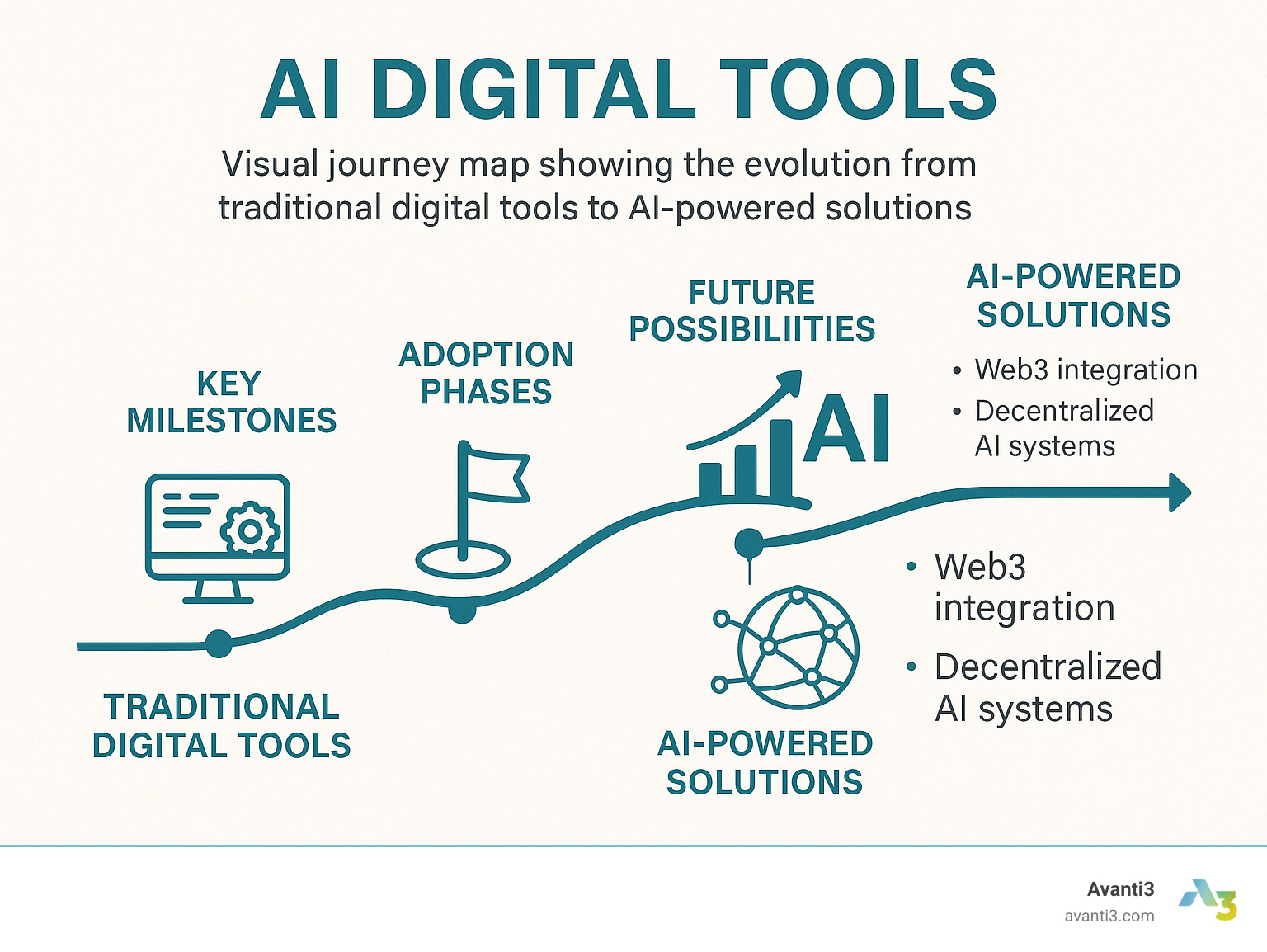
Your next step is simpler than you might think. Pick one AI digital tool that addresses a real pain point in your workflow. Test it on a small scale. Learn how it behaves. Then gradually expand its use as you get comfortable.
The goal isn’t to automate everything – it’s to amplify your best human qualities. The most powerful AI implementations are the ones that make you more creative, more insightful, and more connected to the people you serve.
The future of digital engagement is unfolding before us, powered by intelligent tools that understand context, learn from interaction, and adapt to human needs. Whether you’re looking to streamline operations, create compelling content, or build deeper community connections, the right AI digital tools can help you achieve more than you thought possible.







